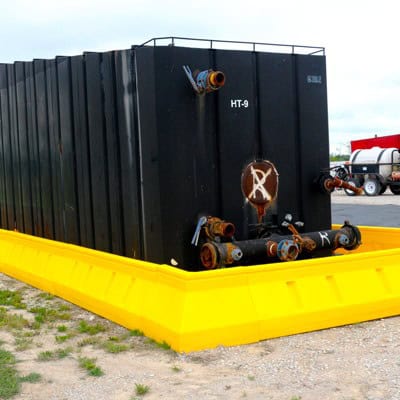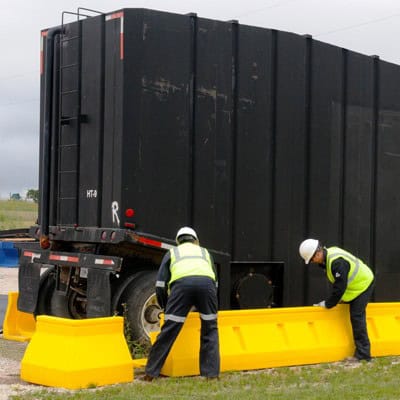In any emergency response plan, managing and containing spills is a critical component. Whether you’re dealing with oil, chemicals, or other hazardous materials, having effective spill containment measures in place can prevent environmental damage and ensure safety. One of the most effective tools in spill management is the use of spill containment berms. In this article, we’ll explore what spill containment berms are, their role in emergency response planning, and how they can be implemented effectively.

Understanding Spill Containment Berms
What Are Spill Containment Berms?
Spill containment berms are barriers designed to contain and control spills of hazardous materials such as oil, chemicals, and other liquids. Made from durable, flexible materials, these berms can be quickly deployed to surround the spill area, preventing the spread of the substance to the surrounding environment.
Types of Spill Containment Berms
There are several types of spill containment berms available, each with unique features tailored to different needs:
- Drive-over Berms: Designed for areas with vehicle traffic, these berms have reinforced edges to withstand the weight of vehicles, allowing for continuous operations during a spill.
- Inflatable Berms: These berms can be quickly inflated and deflated, making them ideal for rapid response situations.
- Folding Frame Berms: With a rigid frame, these berms offer stability and can be easily set up and dismantled.
The Role of Spill Containment Berms in Emergency Response
Spill containment berms play a vital role in emergency response planning for several reasons:
Immediate Containment
When a spill occurs, time is of the essence. Spill containment berms can be deployed rapidly to contain the spill, minimizing the environmental impact and preventing the spread of hazardous materials. This immediate containment is crucial in protecting both the environment and human health.
Versatility and Adaptability
Spill containment berms are versatile and can be used in various settings, from industrial sites to transportation routes. Their adaptability makes them suitable for a wide range of spills, whether it’s a small chemical leak or a large oil spill.
Compliance and Safety
Using spill containment berms helps organizations comply with environmental regulations and safety standards. By having a plan in place that includes effective spill containment measures, businesses can avoid potential fines and legal issues related to environmental contamination.

Implementing Spill Containment Berms in Your Emergency Response Plan
Assessing Potential Risks
The first step in implementing spill containment berms is to assess the potential risks associated with your operations. Consider the types of hazardous materials you handle, the volume of these materials, and the likelihood of a spill. This assessment will help you determine the appropriate type and size of berms needed for your specific situation.
Training and Preparedness
Having the right spill containment berms is only part of the equation. It’s equally important to ensure that your team is trained and prepared to deploy these berms effectively. Conduct regular training sessions and drills to familiarize your employees with the deployment process and ensure they’re ready to respond swiftly in an emergency.
Maintenance and Inspection
Regular maintenance and inspection of your spill containment berms are essential to ensure they’re in good working condition. Check for any signs of wear and tear, and repair or replace damaged berms as needed. Keeping your berms in top shape will ensure they’re ready to perform when needed.
Real-World Applications of Spill Containment Berms
Oil Spill Containment
Oil spills are one of the most common environmental emergencies, and spill containment berms are an essential tool in managing them. By deploying berms around the spill area, responders can prevent oil from spreading, reducing the impact on marine life and coastal ecosystems.
Chemical Spill Management
In industrial settings, chemical spills can pose significant risks to both workers and the environment. Spill containment berms can be used to quickly contain the spill, allowing for safe cleanup and disposal of hazardous materials.
Transportation and Logistics
Accidents during transportation can result in spills of hazardous materials. Having spill containment berms as part of your emergency response plan ensures that you can quickly contain any spills that occur during transit, minimizing the risk of environmental contamination.
Conclusion
Spill containment berms are a critical component of any effective emergency response plan. By understanding their role, assessing potential risks, and ensuring proper training and maintenance, organizations can effectively manage spills and protect the environment. Whether dealing with oil spills, chemical leaks, or transportation accidents, having the right spill containment measures in place is essential for safety and compliance. By incorporating spill containment berms into your emergency response strategy, you can be better prepared to handle unexpected spills and safeguard both your operations and the environment.
Shop at Absorbents Online for Your Spill Containment Needs
Ensure your emergency response plan is fully equipped with high-quality spill containment berms and other essential products. Visit https://www.absorbentsonline.com today to explore our wide range of spill containment solutions designed to protect the environment and enhance safety. Don’t wait for an emergency—be proactive and shop now!